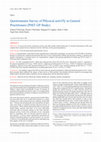Papers by Margaret Cupples
The ESC Textbook of Preventive Cardiology, 2015
The ESC Textbook of Preventive Cardiology, 2015
European Journal of Palliative Care, 2009
Archives of Disease in Childhood, 2011
Objective Interventions to reduce health inequalities for young children and their mothers are im... more Objective Interventions to reduce health inequalities for young children and their mothers are important: involving peers is recommended, but evidence of value for this approach is limited. The authors aimed to examine the effect of an innovative tailored peermentoring programme, based on perceived needs, for fi rst-time mothers in socio-economically deprived communities.
BMC Health Services Research, 2008
Background: Non-professional involvement in delivering health and social care support in areas of... more Background: Non-professional involvement in delivering health and social care support in areas of socioeconomic deprivation is considered important in attempting to reduce health inequalities. However, trials of peer mentoring programmes have yielded inconsistent evidence of benefit: difficulties in implementation have contributed to uncertainty regarding their efficacy. We aimed to explore difficulties encountered in conducting a randomised controlled trial of a peer-mentoring programme for first-time mothers in socially disadvantaged areas, in order to provide information relevant to future research and practice. This paper describes the experiences of lay-workers, women and health professionals involved in the trial.

BMC Research Notes, 2015
Workplace sedentary behaviour is a priority target for health promotion. However, little is known... more Workplace sedentary behaviour is a priority target for health promotion. However, little is known about how to effect change. We aimed to explore desk-based office workers' perceptions of factors that influenced sedentary behaviour at work and to explore the feasibility of using a novel mobile phone application to track their behaviours. We invited office employees (n = 12) and managers (n = 2) in a software engineering company to participate in semi-structured interviews to explore perceived barriers and facilitators affecting workplace sedentary behaviour. We assessed participants' sedentary behaviours using an accelerometer before and after they used a mobile phone application to record their activities at self-selected time intervals daily for 2 weeks. Interviews were analysed using a thematic framework. Software engineers (5 employees; 2 managers) were interviewed; 13 tested the mobile phone application; 8 returned feedback. Major barriers to reducing workplace sedentary behaviour included the pressure of 'getting the job done', the nature of their work requiring sitting at a computer, personal preferences for the use of time at and after work, and a lack of facilities, such as a canteen, to encourage moving from their desks. Facilitators for reduced sedentariness included having a definite reason to leave their desks, social interaction and relief of physical and mental symptoms of prolonged sitting. The findings were similar for participants with different levels of overall physical activity. Valid accelerometer data were tracked for four participants: all reduced their sedentary behaviour. Participants stated that recording data using the phone application added to their day's work but the extent to which individuals perceived this as a burden varied and was counter-balanced by its perceived value in increasing awareness of sedentary behaviour. Individuals expressed a wish for flexibility in its configuration. These findings indicate that employers' and employees' perceptions of the cultural context and physical environment of their work, as well as personal factors, must be considered in attempting to effect changes that reduce workplace sedentary behaviour. Further research should investigate appropriate individually tailored approaches to this challenge, using a framework of behaviour change theory which takes account of specific work practices, preferences and settings.

The Ulster Medical Journal, May 1, 2007
ObjectivesTo assess the levels of physical activity and other health related behaviours of Genera... more ObjectivesTo assess the levels of physical activity and other health related behaviours of General Practitioners (GPs) and compare their reported levels of physical activity with those of the general population.Study DesignCross sectional postal questionnaire survey.MethodsA questionnaire, which did not allow identification of individual respondents, was posted to all 1074 (GPs) in Northern Ireland. It included the validated International Physical Activity Questionnaire (IPAQ) and questions relating to smoking and alcohol consumption. A national survey of a representative sample of the general population of similar age (29-67 years; n = 3010) provided comparative data.Results735 GPs responded (68.4%). IPAQ data indicated that fewer GPs (43.4%) were “physically inactive” compared to the general population (56.2%) (p <0.001) and to a subgroup of professionals (51.8%) (p < 0.016). Compared to the general population, relatively fewer GPs reported smoking (4.2% v 29%; p<0.001); more reported drinking alcohol (86.5% v 71.6%; p<0.001) but fewer reported drinking above recommended limits (12.6% v 16.9%; p < 0.001).ConclusionsOur findings suggest that GPs are better than the general population at following health promotion advice. Since their personal habits influence the impact of their advice to their patients, their healthy lifestyles should be encouraged and further efforts should be made to promote activity among those who are physically inactive.
Bmj, 2002
Margaret Cupples, Bradley Terry, Caryl Sibbett, and William Thompson discuss this dilemma and hig... more Margaret Cupples, Bradley Terry, Caryl Sibbett, and William Thompson discuss this dilemma and highlight some possible solutions Negotiations for a new contract for general practitioners are currently in progress against a background of reports of low morale in the profession ...

Systematic reviews, 2015
Cardiovascular diseases (CVDs), including myocardial infarction, heart failure, peripheral arteri... more Cardiovascular diseases (CVDs), including myocardial infarction, heart failure, peripheral arterial disease and strokes, are highly prevalent conditions and are associated with high morbidity and mortality. Cardiac rehabilitation (CR) is an effective form of secondary prevention for CVD but there is a lack of information regarding which specific behaviour change techniques (BCTs) are included in programmes that are associated with improvements in cardiovascular risk factors. This systematic review will describe the BCTs which are utilised within home-based CR programmes that are effective at reducing a spectrum of CVD risk factors. The review will be reported in line with the preferred reporting items for systematic reviews and meta-analyses (PRISMA) guidance. Randomised and quasi-randomised controlled trials of home-based CR initiated following a vascular event (myocardial infarction, heart failure, peripheral arterial disease and stroke patients) will be included. Articles will be...
The Ulster medical journal
We resolved to prescribe folic acid supplements for all women who attended this practice during t... more We resolved to prescribe folic acid supplements for all women who attended this practice during the first twelve weeks of pregnancy. Six months after this decision a prescription was recorded in only 13% of cases: this compared with 18% during the two months immediately following the decision. It was resolved to improve this performance and observations six months later revealed a prescription recorded in 63% of cases. Subsequently a new form for recording an antenatal consultation was devised and six months after its implementation, 100% recording of folate prescription for appropriate cases was observed. It was concluded that these simple audit exercises prompted changes in practice which helped to improve standards of patient care.
British Journal of General Practice
... MRCGP examination Daniel Toeg 385 Counselling: scientific evidence needed Wayne Lewis 386 Pat... more ... MRCGP examination Daniel Toeg 385 Counselling: scientific evidence needed Wayne Lewis 386 Patients who do not receive continuity of care N Stuart P Handysides 386 Acute myocardial infarction M Keith Thompson; J O'Sullivan; Mark A Rickenbach 386 Skin biopsies in ...
The Ulster medical journal

The Journal of the Royal College of General Practitioners
Psychotropic drug prescribing in a group practice was studied retrospectively. Approximately two-... more Psychotropic drug prescribing in a group practice was studied retrospectively. Approximately two-thirds of patients considered to have psychosocial problems were being treated with psychotropic drugs. Compared with the remaining patients with psychosocial problems not prescribed psychotropic medication these patients were more likely to be older, to have no children in the household and to have a past history of physical illness but were less likely to have an acute physical problem or to have a social factor contributing to their mental problem. Sedative and antidepressant drugs were prescribed with similar frequency for all age groups but 75% of hypnotic drugs were prescribed for the elderly.The study provides evidence that while a high proportion of patients with psychosocial problems receive a prescription for a psychotropic drug, general practitioners are discriminating in their prescribing.
The Ulster medical journal
We report a study of the association of health and social support variables with motherhood in te... more We report a study of the association of health and social support variables with motherhood in teenagers and older mothers. Both teenage and older mothers reported poorer physical and mental health and fewer and less frequent social contacts than their nulliparous peers. Contrary to expectation, however, older mothers reported less extensive and less adequate social support networks than did teenagers.
British Journal of General Practice
ABSTRACT
British Journal of General Practice
The Ulster medical journal
Reducing the prevalence of smoking in pregnancy is a priority target for health care. We administ... more Reducing the prevalence of smoking in pregnancy is a priority target for health care. We administered a semi-structured questionnaire to mothers in an inner city general practice who were given brief anti-smoking advice during routine antenatal care. Of a cohort of 113 mothers, 52(46%) reported smoking at the start of pregnancy. Six(12%) of these 52 smokers reported no change in smoking habit during pregnancy; 24(46%) cut down; 12(23%) stopped; 10(19%) increased their cigarette consumption. Of the 52 smokers, 41(79%) believed smoking was harmful to an unborn baby, yet 30(73 %) of these women continued smoking. Almost all recalled having been given anti-smoking advice by the GP and/or hospital. There is an urgent need to identify more effective methods of reducing smoking in pregnancy.
British Journal of General Practice











Uploads
Papers by Margaret Cupples